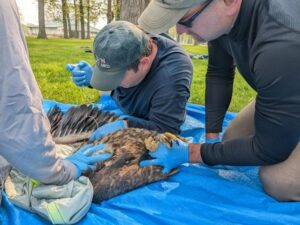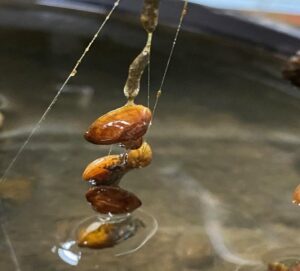I recently attended a meeting on PFAS and its impact on wildlife. From bald eagles nesting near Lake Superior to mussels in the Mississippi River, scientists are increasingly studying Wisconsin wildlife for signs of the impact of ingesting the forever chemicals more commonly known as PFAS.
Per- and polyfluoroalkyl chemical compounds, or PFAS, are odorless and tasteless chemicals that have been showing up in private and public water systems across the state.
The chemicals have been around for decades and are associated with hundreds of products people use including firefighting foam, non-stick cookware and stain-resistant clothing. They are linked to health problems in humans, including certain cancers and liver.

Scientists with the Wisconsin Department of Natural Resources work to sample nestling eagles to learn more about how PFAS may be impacting them near Lake Superior. Photo Courtesy of the Wisconsin DNRdisease.
“What we know is it (PFAS contamination) is pretty much everywhere,” said Sean Storm, a Wisconsin DNR fish and wildlife toxicologist. “We have detected it in numerous areas across the state. Not surprisingly, as we’ve seen with levels in fish, there are certain parts of the state where levels seem to be higher than others.”
“We first started looking at PFAS in wildlife back around 2007, and then we started doing it a little bit more regularly in 2011 and have been looking at it on and off since then,” Storm said.
“Most of the wildlife/PFAS data we have is in eagles. Through this work, we have identified that the Wisconsin River has higher levels than elsewhere in the state. We don’t know why,” said Storm. “We are still learning in terms of what harmfully impacts PFAS exposure can cause (in wildlife). Things like thyroid function, issues with reproduction and behavior. It might not be the PFAS are making birds overtly sick, but they might not be behaving as others who are unexposed,” he added.
This summer, the DNR gathered samples from eagles on the south shore of Lake Superior. The sampling is part of a multi-state study with Minnesota and Michigan.
Earlier this year, biologists at the Genoa National Fish Hatchery began studying how PFAS in the Mississippi River are impacting mussel populations.
“We have undertaken this research because PFAS are an emerging contaminant and we don’t know enough about what risk they pose to aquatic organism,” said Megan Bradley, the lead mussel biologist at Genoa.
Bradley said at Genoa, they hope to learn more about the amount of PFAS in the water and sediment of the Mississippi River and how native mussels are dealing with the contamination.

Plain Pocketbook mussels cultured for Mississippi River contaminants of emerging concern study. Photo courtesy of the U.S. Fish and Wildlife Service between Genoa and Dubuque, Iowa.
“We are taking samples of well water and surface water and we’re sampling the sediment they grow in, because we don’t really know for sure yet where the PFAS could be coming from. We’re eventually going to be looking at the PFAS levels in the animals,” Bradley said.
Bradley said it will take another 10 months to grow the mussels and it could be three years before some results are known. Bradley said the study’s results could be used by the Environmental Protection Agency to set water standards for wildlife and PFAS.
The wildlife studies are happening at the same time studies of human exposure to PFAS are ongoing. For Sean Strong, potential solutions to PFAS contamination in wildlife will help humans and vice versa.
“We want to understand the exposure levels of fish and wildlife to PFAS and other contaminants, identify problem locations and then (determine) if there are populations that are more at risk than others,” he said.
Strong said it could take several months for the DNR to have results of the eagle study in northern Wisconsin.
